Food for Flyers
It had been six weeks since his food money ran out.* He went to class, just as he had before, ignoring the hollow ache from his stomach and trying to focus on the lecture. But six weeks is a long time, and his academic adviser noticed something was wrong: Were the student’s clothes getting baggier? Or was his frame getting thinner?
They talked, and the student shrugged off his need. It was only three weeks until finals. He’d scraped by with so little for this long, surely he could last until the end of the semester.
The adviser shook his head no, there was a better solution, and referred the student to the Food4Flyers food pantry. Located at ArtStreet in the Brook Center for Empowerment and Wellbeing, the pantry provides students with food and hygiene supplies.
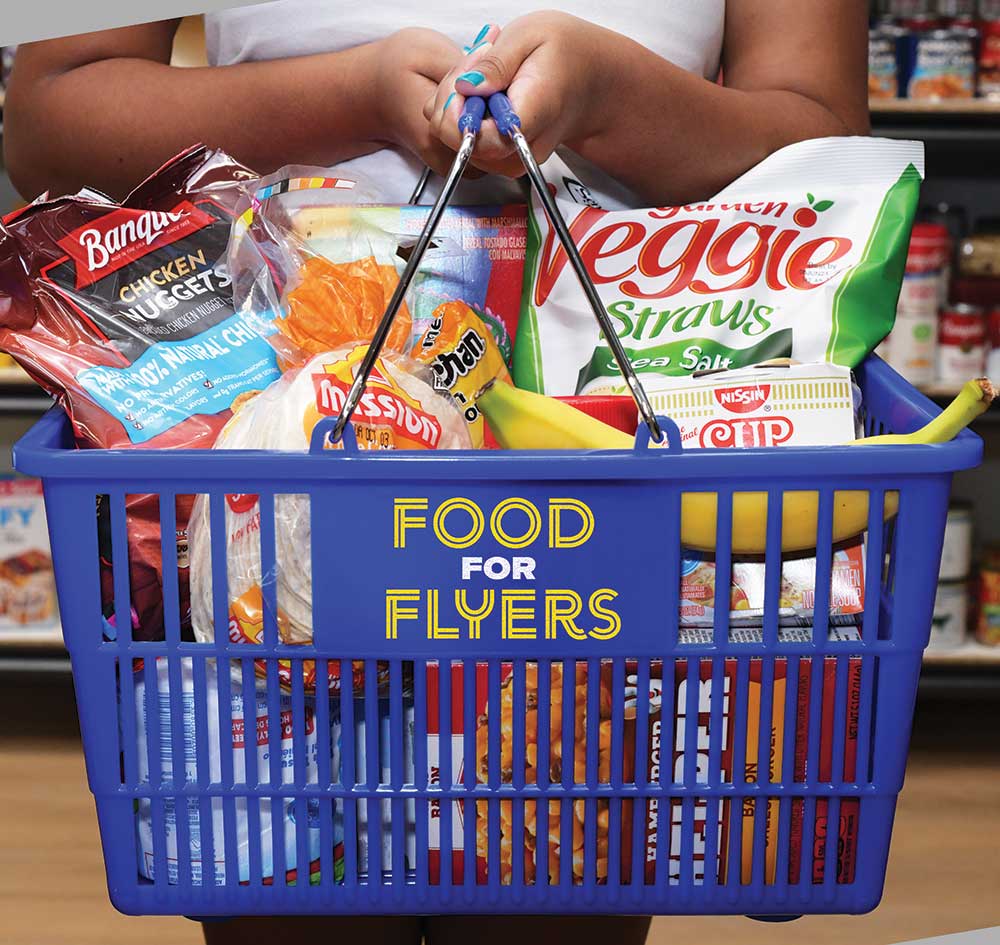
“What Food4Flyers says, at the very basic level, is we care about who you are, we care about your success, and we care about making sure that you have the tools that you need in order to be successful here. And we’re not going to let something like food stand in your way,” said Kristen Altenau Keen, assistant dean of students and director of the Brook Center.
The reality is that a basket full of groceries can make the difference between a student succeeding or the student missing class, doing poorly or even dropping out.
Renovated this summer, the Food4Flyers pantry is helping combat food insecurity, a term that refers to a student not knowing where their next meal is coming from. It’s an increasing problem nationwide and one reported by more than one-third of students during their time at UD. In true Marianist spirit, the University of Dayton is helping address the problem by offering food, community and belonging to help students succeed.
Founding the food pantry
When Food4Flyers opened Oct. 1, 2021, it offered a colorful row of breakfast cereals, stacks of canned sweet peas and other shelf-stable foods arranged on wooden bookshelves in a closet that housed the building’s water heater.
The food pantry’s humble beginnings belie the mountain of work put in by dozens of people to make it happen. It filled an immediate need with 2,000 items donated by a community member.
Before the food pantry, there were anecdotal stories of hungry students from faculty members who would hand out granola bars pulled from their desk drawers. Case managers in student development would refer students to the Dayton Foodbank, an off-campus community resource that sometimes posed a transportation challenge.
Chris Schramm, associate vice president for student development and dean of students, and Bill Fischer, vice president for student development, called together a working group in September 2019 to channel all the individual good deeds into a solution guided by the Marianist mission to educate — and care for — the whole person. Around an oval table in Gosiger Hall sat staff representing student development, Campus Ministry, enrollment management and dining services, plus students and faculty.
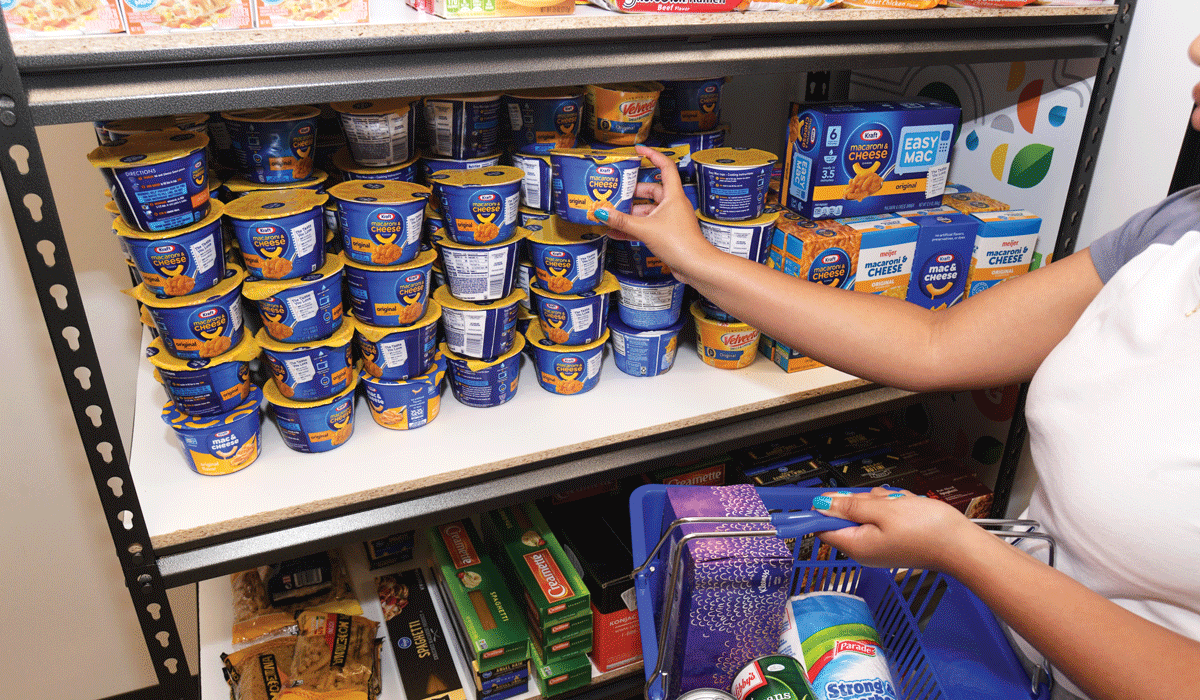
Lindsay Maxam, then an assistant dean of students, led the working group as members discussed the need they saw on campus. They talked with students. What they learned busted one myth: Students were not spending their food money on beer. Instead, students who struggle financially put tuition first — and food last.
They decided to establish a food pantry at the Brook Center, in collaboration with the dean of students office, in the heart of the south student neighborhood.
The Brook Center was named for a quote by Father William Joseph Chaminade, one of the Marianist founders, who saw the power of moving water as a metaphor for overcoming all obstacles.
The obstacle was hunger, but the Brook Center was poised to offer so much more.
“The Brook Center is about relationships — that’s the core of who they are, and this food pantry discussion isn’t just about, ‘I need food and I need food now,’” Schramm said. “It’s about our relationship with food. It’s about how we plan for food, how we think about food, how we budget for food, how food plays a role in our lives — and not just necessarily feeding our bodies but feeding our souls. It’s a community builder, and what better place to put that than in the Brook Center?”
They spread the word — and students came. In Food4Flyers’ first 20 months, students visited the pantry 1,485 times for food and hygiene supplies, including deodorant, toilet paper, menstrual products and toothpaste.
In that time, the pantry has received more than 5,300 items, almost all donated from the campus community.
It is a pantry for the community, stocked by the community.
“Without the generosity of our faculty, staff, students and alumni, the pantry would not be able to run,” Keen said.
Need nationwide
Going hungry can look different for each student.
For one UD student, it happened when a housemate finished the box of cereal the student had budgeted to get her through breakfasts for the rest of the week — and she had no money to buy more.
That housemate likely didn’t know what she had done. Students who are food insecure report feeling shame, and they hide their need through words and behaviors that can leave even those they live with in the dark.
Of the 36,000 students nationwide who participated in the fall 2022 Student Financial Wellness Survey, 46% reported some level of food insecurity. More than a quarter responded affirmatively to each of these statements:
- I couldn’t afford balanced meals.
- I bought food but it didn’t last and I had no money for more.
- I cut the size of my meals.
- I ate less than I felt I should.
- I was hungry but did not eat.
Two UD professors asked Flyer students questions about food security between 2017 and 2022 — before double-digit inflation. They found 36% of UD students reported being food insecure during their time on campus.
They found 36% of UD students reported being food insecure during their time on campus.
The professors — Diana Cuy Castellanos, professor of health and sport science, and Jeanne Holcomb, professor of sociology — joined their UD data with data from colleagues at Chaminade University in Honolulu and St. Mary’s University in San Antonio to provide information on the state of food insecurity across the three Marianist universities.
Generally, they found at Marianist universities that those with higher food security tend to be graduate students; students who have access to a car; students with higher GPAs; students who are not international students; students who do not receive Pell Grants; and students who live off campus. For example, commuter students who live with their families report that they are more likely to join in regular family meals. Students living on campus and not enrolled in a seven-day-a-week meal plan are more likely to struggle with food. First-generation college students are more likely to go hungry.
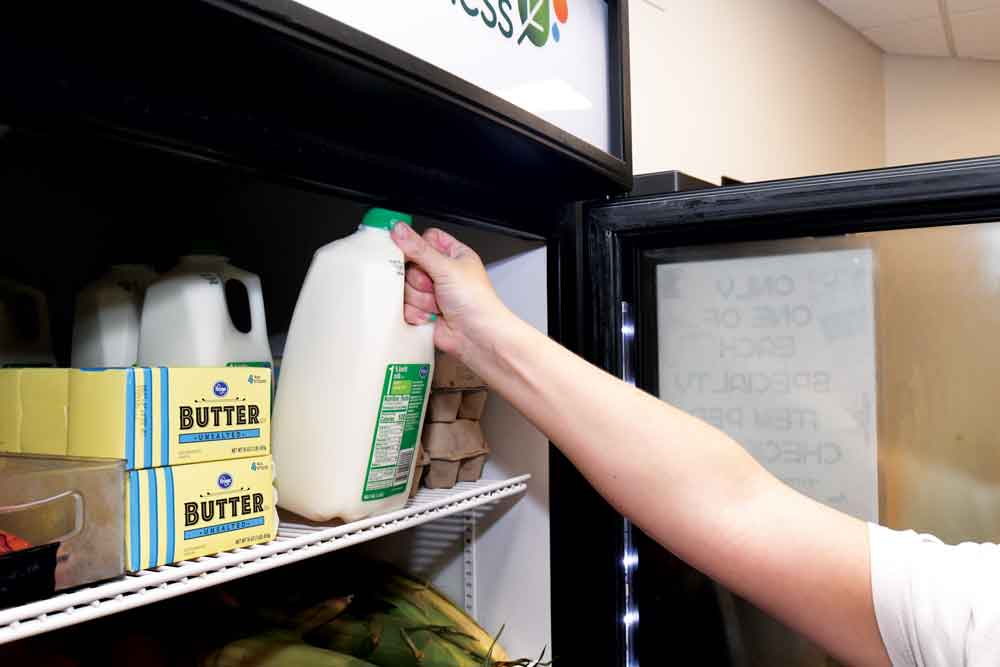
Paul Schweickart knows these statistics. He also knows the personal stories behind the students who struggle. As assistant dean of students for advocacy and intervention, he and case manager Katie Noah help students who, for whatever reason, get a referral to their office. The student could be struggling with mental health, failing to come to class or having trouble with a roommate. Each of these circumstances could contribute to food insecurity.
His conversations with students can sound casual: What time do you get up? Who do you go to breakfast with? Tell me about your favorite meal to eat with friends.
But they yield important information.
“You get a sense of when someone is eating regularly and who they’re eating with, or if they’re doing behaviors or performing in a way where they’re kind of hiding away or not taking care of themselves,” he said.
Busy students say time constraints around classes, employment and extracurriculars are barriers to food access. But eating is a community event at UD. If students don’t eat with others or avoid interactions during traditional mealtimes, then students are missing out on opportunities to connect, grow and learn, Schweickart said.
Cost can be a barrier to food access on campus, especially for students who report limited financial support from their parents. Budgeting and cooking skills also emerged as factors influencing food intake, according to the report.
But not eating has costs far beyond being hungry. The Marianist universities study found students who experience food insecurity have lower GPAs and miss class far more often.
It also impacts retention, Keen said. When students leave for financial reasons, they are not saying it’s because they didn’t have anything to eat for breakfast. But not having breakfast is an indicator of need, and those needs, left unaddressed, can pile up into a crisis that threatens the student’s ability to stay in school.
Catherine Weber Mix ’02, associate vice president of student enrollment services, is a member of the Student Crisis Fund advisory committee, which receives more than 200 requests each year for assistance. The most common request is for food and other basic needs like hygiene products.
The committee connects students with Food4Flyers, helps them sign up for federal SNAP benefits and reviews their financial aid package.
“If we can provide resources and meet the needs of students in the moment, then we minimize the crisis the student is experiencing — and they can again see themselves as productive students,” she said.
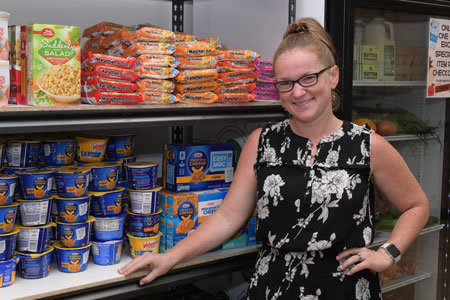
Recalling Maslow’s hierarchy of needs, physiological needs such as food must be met long before we can expect students to make the most of what a UD education
offers, Keen said.
“If they are sitting in class hungry, they’re never going to be able to figure out, how do I acquire that internship? How do I critically think about this undergraduate research opportunity? How do I engage in a meaningful conversation with a mentor if I’m sitting here hungry?” she said. “We need to give them the tools for their brains to be able to function at their highest level.”
An upgrade
It was only Tuesday morning, and the bananas were already gone.
Keen was giving a tour of the new food pantry space, a renovation made possible by the $30,000 gift from Doug Lyons ’79 and Janie Lyons. No longer was the pantry in a cramped closet. The new 375-square-foot space now included a half dozen shelving units packed with items. Inside a full-sized fridge were half-gallons of milk, packs of cheese slices and a mound of ruby red Roma tomatoes picked fresh from UD’s garden at Old River Park. Next to it stood a full-sized freezer with bags of chicken for students to add to their blue shopping baskets.

“August is especially busy,” Keen explained, as students returning to school await the first paycheck from campus jobs. Many students also use the pantry near the end of semesters as expenses outmatch the funds they allocated for meal plans or grocery bills.
A student might stop by once, for help in an emergency. Others might need food monthly. Those with persistent needs are connected with other University and community resources.
Bananas and apples go most quickly, Keen said, and are part of regular deliveries from a local grocery store. Ramen and macaroni and cheese are most popular with students. Items like rice, cooking oil, hygiene products and paper products are always needed through donations.
At the end of last spring semester, students who had money left on their flexible meal plans could choose to donate it to the food pantry — and they picked out items they wanted to donate. In the first 24 hours, students donated 300 toothbrushes. Today, stacked atop shelves and cabinets in the food pantry are cardboard boxes full of Easy Mac and packets of chicken ramen, all donated by students.
One student shopping at the pantry picked up a box of mac and cheese and a can of green beans, mentioning to a Brook Center staff member that it would last her a week. The staff gently encouraged her to take more.
Senior Logan Trzeciak, a staff member who assists shoppers in the pantry, said their training focuses on the dignity of each student.
“The biggest thing is making sure that they felt welcome in the space.”
“The biggest thing is … making sure that they felt welcome in the space, making sure that they didn’t feel like they were less than us because they were coming to the food pantry,” said Trzeciak, who also used the pantry when a paycheck was
delayed.
While the pantry serves students from all populations — domestic and international, traditional and nontraditional — donor Doug Lyons said he’s especially sensitive to the needs of first-generation college students like he was. That’s why his family designated their most recent gift to the Brook Center, which he toured earlier this year.
“I asked what their biggest need was, and they said expanding the pantry and making it more functional,” he said. “UD gave me a lot in my life, and I feel the need to give back in ways that address inequality.”
About more than just food
The semester had just begun, and already students were appreciating the renovated food pantry and all it had to offer.
“They’re walking into this space and their eyes are lighting up,” Keen said. “I mean, it’s just a sense of dignity that we didn’t have before, more than we’re sticking peanut butter in a closet for you.”
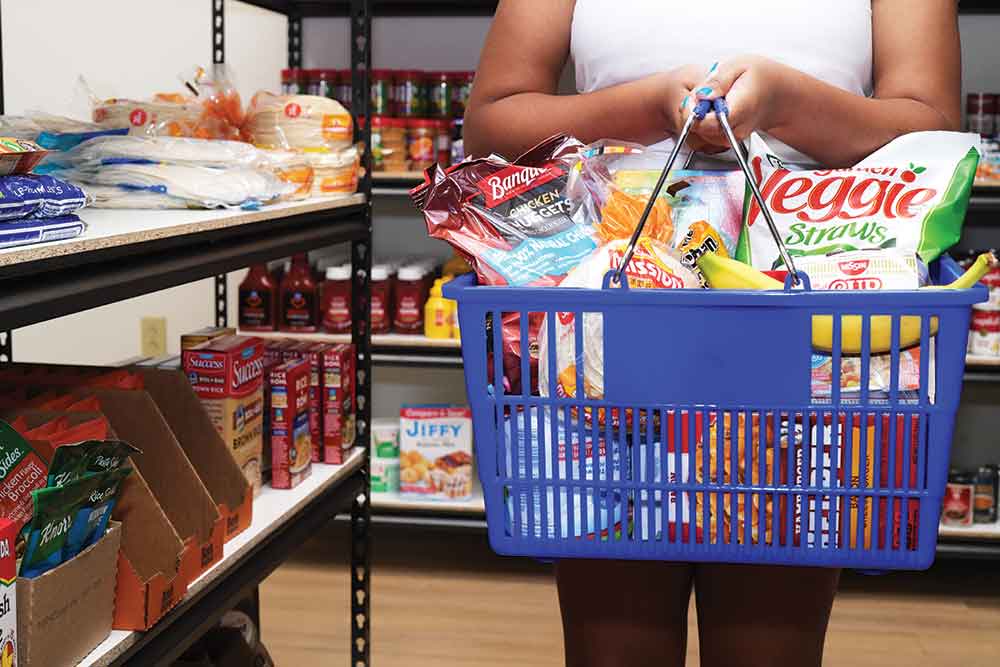
The Lyons family donation to expand the pantry is a visible sign that the extended UD community cares for each of its students. It’s also evident in how the food pantry is resupplied. Every month, several campus offices collect donations. Cash donations from alumni and others are used by the pantry to stock dairy, produce and frozen foods.
“It always just makes my heart react when [students] say, ‘You’ve got the good stuff,’” Keen said. “We’ve got Cheerios. We have Jif peanut butter. They’re not walking back to their houses with this bag of generic groceries and it’s screaming, ‘I’ve been at the food pantry.’ They’ve got the same stuff that their roommates have.
“We can’t underestimate the power and significance of that.”
While community may be the University’s greatest strength, it can also be the greatest weakness, Keen said. If you hear that UD has the happiest campus, but you are struggling to fill basic needs or see yourself as a member of a population that’s not seen or valued, you can feel even more marginalized.
“I think, like so many things in society now, we’re talking about it in a way that we’ve never talked about it before,” Keen said of food insecurity. “I think people at UD make all kinds of assumptions about the student body that we have here — that they all have summer homes and they jump on their helicopters and they fly off, and it’s just not the reality.”
“I think people at UD make all kinds of assumptions about the student body that we have here ... and it’s just not the reality.”
Fall semester, the Brook Center is stocking Easy Mac bowls at campus locations where students would be likely to discuss their hunger, such as the counseling and health centers. Students get immediate sustenance, and a sticker on the bowl shares the location and hours for the food pantry.
On the horizon is a partnership that aims to make food and community more accessible. Joan Bauman, executive director of dining services, said she hopes by the end of fall semester to have a system in place where case managers in the dean of students office can provide preloaded meal cards, so students who use the pantry will also be able to sit down and share a meal with friends in the dining halls.
Said Keen, “When you think about sense of belonging, eating at the dining hall next to your friends is huge.”
Since belonging is key, Food4Flyers is intentional about how it makes food available. Any undergraduate can walk in, no questions asked. Graduate students have a short conversation about their possible array of needs before picking out items for the first time. Students can schedule shopping times to help maintain privacy.
Brook Center staff also recognize that food isn’t the only barrier to healthy eating. Students may not have a can opener or the pots and pans needed to cook meals, so those are items they are looking to stock in the future.
Students, especially those on their own for the first time, might not know how to cook. To fill that need, Food4Flyers partnered with a faculty member, who assigned a class project that included creating recipe cards with meals easily assembled from food pantry staples.
One time, the pantry received a huge delivery of beets fresh from the campus garden. But do students know what to do with beets? Brook Center staff offered a cooking demonstration and shared samples for students to try before filling their grocery bags with beets to take home.
Keen envisions the kitchenette at the pantry getting an upgrade, allowing for more education that, when paired with access to food, can help feed a person’s body, mind and soul and set them up for future success.
Because when everyone is at the table, the fullness of community becomes reality.
*Student stories are based on facts but details have been changed to protect privacy.
Michelle Tedford is editor of UD Magazine. In October, she will join a team of UD bicycle riders in the Tour de Gem to raise funds for Food4Flyers.
Here today and tomorrow
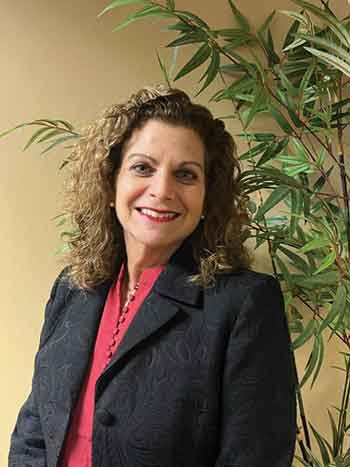
Students come to UD with an expectation of success, but life events can upend those plans.
Chris Schramm, associate vice president for student development and dean of students, recalled how that happened for one student when her father died unexpectedly. The emotional toll on her whole family was overwhelming, and the student now also had to navigate a new financial reality. Not only was tuition a stretch, but every other expense — down to how she would eat — was called into question.
The University of Dayton had a system in place to help the student, and she was able to stay on and graduate.
It’s the Marianist foundation that makes it possible — and necessary — said Schramm. It’s also a safety net available to every student.
“We’ve got systems and processes in place that strive for equitable and fair outcomes,” Schramm said, “because the University has said everyone should have access to basic needs and assistance with inevitable obstacles along the way, freeing the path so you can continue to go to class and achieve the goal of graduation.
“We can say to them, ‘I can’t take away the loss of your father. But if I help neutralize this crisis over here, why don’t you go to class, and we’ll have what is required to get you the assistance you need. You can go to the food pantry and eat something, do your homework, go to sleep, go to class in the morning, and we’ll be here for you to help pick up tomorrow.’”
The Chronicle of Higher Education reported on several college programs that provide emergency-aid programs to help students stay in college and graduate. A 2022 study at State University of New York reported that students who had received emergency aid were significantly more likely to persist, seek campus resources and feel a stronger sense of belonging. At Milwaukee Area Technical College in Wisconsin, a survey found 93% of students who applied for funds from the national organization Faculty and Students Together to cover emergency expenses, such as car repair, utility bills, school fees and food, were still enrolled, had graduated or had transferred to another institution.
Among the resources available at UD is the Student Crisis Fund, which received overwhelming support from alumni and parent donors during the pandemic. The fund can, for example, help with expenses related to traveling home for a funeral. Students whose financial needs have changed can appeal for additional aid to help with tuition and housing. Dining services extends meal plans for students who are without funds to eat through the end of the semester. Campus locations such as the Multi-Ethnic Education and Engagement Center have donor-funded budget lines that assist when students need a replacement computer or funds to participate in study abroad. Student development even has an advocate who can help students negotiate down medical bills.
Through case managers, students also get connected with local resources
for housing, car repair, public transportation and extended mental health
services, to name a few.